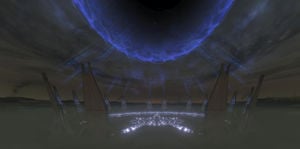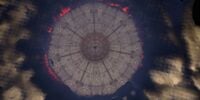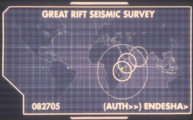Portal at Voi: Difference between revisions
From Halopedia, the Halo wiki
mNo edit summary |
Sith Venator (talk | contribs) |
||
| Line 89: | Line 89: | ||
*''[[Halo 2 Anniversary]]'' | *''[[Halo 2 Anniversary]]'' | ||
**''[[Terminal/Halo 2 Anniversary|Terminals]]'' | **''[[Terminal/Halo 2 Anniversary|Terminals]]'' | ||
*''[[Halo: Spartan Strike]]'' {{Mo}} | |||
==Sources== | ==Sources== | ||
Revision as of 22:13, January 26, 2015
| Portal at Voi | |
|---|---|

| |
| General overview | |
|
Description: |
Disc with seven pairs of rising monoliths/petals |
|
Location: |
East of Voi, Kenya, East Africa, Earth |
| Operation overview | |
|
Type: |
Slipspace portal generator |
|
Function: |
To allow access to the Ark |
|
Date of construction: |
|
|
Status: |
Closed, yet still drawing power from an unknown source[1] |
| Structural information | |
|
Diameter: |
117 kilometers (73 mi)[2] |
The Portal at Voi,[2][3] known to the scientific community as the Excession at Voi or simply the Excession[1] and sometimes referred to as the Artifact,[4] is a Forerunner artifact in Kenya, Africa on planet Earth, designed to generate a slipspace portal to Installation 00. It was buried between the town of Voi and the city of Mombasa, and uncovered by the Covenant during the Battle of Earth in late 2552.
History
Ancient history
Shortly before the firing of the Halo rings, the Forerunner known as the Librarian ordered the construction of the portal beneath a savanna in what would later become Kenya. The Librarian knew that the portal would not be complete before the Halos were fired, and thus construction would continue for at least a century after the Earth was reseeded. She built the portal with the hope that humanity would one day find it and reap the benefit of the legacy the Forerunners left on the lesser Ark. Using a Gargantua-class transport, sent by 343 Guilty Spark at her request, the ship along with the necessary components mined from the Earth were used to build the portal.[5] At some point after this event, an ancient African elder named N'chala witnessed the Portal's construction by Strato-Sentinels.[6] The portal was operational by the time the Reintroduction phase of the Conservation Measure was initiated and life was reseeded on Earth.[7]
Discovery

The Portal was originally both underground and submerged, lying at least partially under a man-made lake. By November 17, 2552, the entire lake and the earth below had been vaporized by Covenant ships to unveil the artifact.[8] At some point, the UNSC's Office of Naval Intelligence discovered a small section of the Portal structure located below the metropolis of New Mombasa, and constructed a major facility known as the ONI Alpha Site in the city in order to conduct covert research on the artifact.[9] In October 2552, a seismic anomaly indicating the location of the Portal was discovered in a survey conducted by New Mombasa's urban infrastructure AI, the Superintendent for Dr. Endesha, revealing the full extent of the structure.[10]
Following the Prophet of Regret's retreat from Earth during the Battle of Earth, a massive Covenant fleet led by Jiralhanae arrived to swiftly take control of the battle from the Sangheili. The Covenant attempted to use the data gathered by the Superintendent to pinpoint the location of the artifact, but were eventually forced to discover its location on their own. On the same day, they started the uncovering of the artifact by glassing. The process would be completed on the 17th of November, when the Prophet of Truth arrived at Earth. The Prophet of Truth landed the Forerunner Dreadnought on the Forerunner structure, and an unusual electric storm started up above it. Before its activation, he traveled to the Superintendent's data center deep under New Mombasa, now occupied by a number of Covenant Huragok, and observed the section of the artifact visible from the facility.[11]
The UNSC military unit ONI Recon 111 reported to Commander Miranda Keyes that the "cruisers above the crater have stopped...they've found something."[12] The UNSC attempted to attack the structure, falsely presumed to be the Ark by UNSC intelligence; but was unsuccessful due to heavy Covenant anti-aircraft batteries. A small strike force in the city of Voi, consisting of John-117 and some Marines and factory workers, neutralized an AA battery to clear a path for three frigates and numerous Longswords. These then made several attacks on the Dreadnought with MAC cannons and air-to-air missiles, but with no effect. Truth then activated the gateway, opening a large slipspace rift above the Portal which led to the real Ark, which was revealed to be outside the Milky Way galaxy. Truth and the rest of the Covenant loyalist fleet advanced through the rift as the Sangheili fleet, while Thel 'Vadam, Miranda Keyes, and John-117 pursued them to the Ark. While the Flood-infested Covenant capital city High Charity soon followed them to Installation 00, the Gravemind was able to jump to the Ark from near Mars rather than accessing the Voi portal due to its access to arcane Precursor techniques and its extensive modifications to the former holy city.[13]
In 2553, after the battle, civilian xenoarchaeologists were hired by the Office of Naval Intelligence to study the artifact. While closed, it was still drawing power from an unknown source and the majority of the passageways below it were still unexplored.[1]
Behind the scenes
Appearances
The storm was first seen in the Halo 3 Announcement Trailer, when the camera shows the artifact being uncovered and activated. The storm lies directly over it, lightning bolts are seen flashing out of the clouds, and the formation seems to have an eye, like a hurricane would. When the portal is activated, the beam travels up through this eye and disappears.
In the level Crow's Nest, when a player looks up at some of the computer monitors, you will see a map of the local area. The map will have a mass of clouds beginning to show a swirling motion around the area. When you enter the level Tsavo Highway, you can see a doughnut-shaped mass of clouds above the artifact that the Covenant are excavating. When you proceed to the level The Storm, the storm has intensified and grown. The clouds now bring rain to the area, and certain parts of the cloud glow as if cloud-to-cloud lightning is occurring. At a point in the level The Storm, a group of UNSC Marines are present around a radio. Intel comes over the communications channel and says, "...winds inside the storm have been clocked at over 200 kilometers per hour." When Truth activates the Portal, the solid blue beam shoots up into the cloud formation's eye and opens the portal to the Ark.
After the portal is opened, and the level Floodgate begins, the remains of the clouds are seen broken up and swirling around the portal in the sky, having been disrupted by the opening of the portal itself.
At the end of Halo 3 where Lord Hood is making his concluding tribute speech about the Human-Covenant War and the Marines who died in the strife and war, one can see the now-inactive Portal when the Phantom comes to transfer the Arbiter to the Shadow of Intent.
The artifact is also seen in the ending cinematic of Halo 3: ODST, where a fleet of Covenant ships are excavating the object.
Size
Before Halo: The Essential Visual Guide established a definite diameter for the Portal, there was some confusion as to its size. This was due to a conflict between the in-game sizes of the Forerunner Dreadnought in Halo 2 and Halo 3, the latter depicting the ship as being far smaller than its former incarnation.
Based on the map geometry in Halo 3, the Portal can be estimated to be approximately 25 kilometers in diameter.[14] However, this figure is contradicted by the geography of the Portal's surroundings; as evidenced by Halo 3 and Halo 3: ODST, the structure stretches from the edge of the metropolis of New Mombasa all the way to the edge of Voi, a distance well over 100 kilometers.
The canonical size of the Portal is derived by referencing the in-game measurements of the Forerunner Dreadnought from Halo 2.[15][16][17][18] The sizes of the Portal and the Dreadnought in Halo 3 are taken as a liberty due to engine limitations; generating map geometry for over a 10,700 km2 area would be extremely taxing, if not impossible, within the game engine.
It should be noted that these estimations are centered around the the size of the excavated portion of the Portal. The extent of the underground installations surrounding it is still unknown.
Trivia
- In the "Behind the Scenes" section on the Halo 2 Collectors Edition, there is a sketch of the Portal upon activation.
- When the frontal half of the UNSC Forward Unto Dawn came back to Earth through the portal, instead of exiting it above the structure where the Slipspace rift would be, it ended up exiting in Earth's orbit, due to the portal being closed. This indicates that from the Ark, one-way access through the portal was possible, even if the portal was closed.
- The 14 monoliths/petals that lift up after activation of the portal is another reference to the number 7 (7+7=14). The entire structure seems to be constructed of seven identical parts, with seven pairs of monoliths/petals. The Portal is 117 kilometers in diameter, a direct reference to John-117.
- It has been further stated by Bungie that at one point, during story conception, the area that ended up being the Portal had originally been intended to be the Ark itself. Interestingly, the UNSC assumes the portal is the Ark as it nears activation, particularly during the levels Tsavo Highway and The Storm.
- The monoliths/petals bear a striking resemblance to the monoliths around the Atmosphere Processor from the film Aliens.
- The portal mechanism encountered in the first chapter of Spartan Ops Episode 7 shares a near identical design to that of the Voi portal; with monoliths that withdraw downward when the portal is deactivated. Presumably it is a similar technology on a much smaller scale.
Gallery
- Ark sTITCH.jpg
"The Ark" seen in the Halo 2 Collector's Edition DVD.
List of appearances
- Halo 3 (First appearance)
- Halo 3: ODST
- Halo Legends
- Halo: Evolutions - Essential Tales of the Halo Universe
- Human Weakness (Mentioned only)
- From the Office of Dr. William Arthur Iqbal (Mentioned only)
- Halo: Silentium
- Halo: Rebirth
- Halo: Broken Circle (Mentioned only)
- Halo 2 Anniversary
- Halo: Spartan Strike (Mentioned only)
Sources
- ^ a b c Halo: Evolutions - Essential Tales of the Halo Universe, From the Office of Dr. William Arthur Iqbal
- ^ a b Halo: The Essential Visual Guide, page 146
- ^ Halo: Evolutions - Essential Tales of the Halo Universe, "Human Weakness", pages 382, 395
- ^ G4TV Bungie Interview, December 8, 2009
- ^ Halo: Silentium, String 37
- ^ Halo 3: The Cradle of Life
- ^ Halo: Rebirth
- ^ Halo 3, campaign level The Storm
- ^ Halo: The Essential Visual Guide, page 132
- ^ Halo 3: ODST, Sadie's Story
- ^ Halo 3: ODST, Legendary ending cutscene
- ^ Halo 3, campaign level Tsavo Highway
- ^ Halo Waypoint - The Halo Bulletin: 9.24.14
- ^ halo.bungie.org: Artifact Sizing *Minor H3 Spoilers*
- ^ Halo 2
- ^ Halo 3
- ^ Halo 3: ODST
- ^ Halo.bungie.org: Determining the Real Sizes of Objects in Halo







